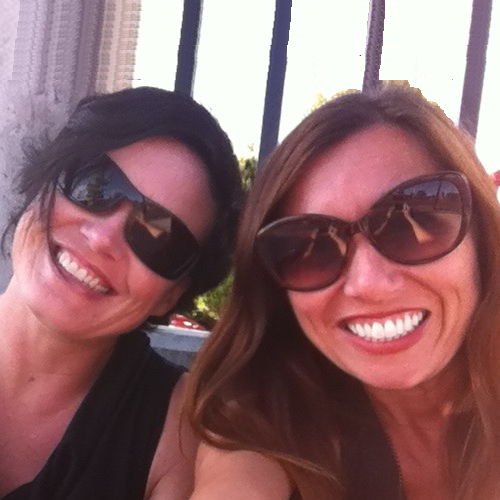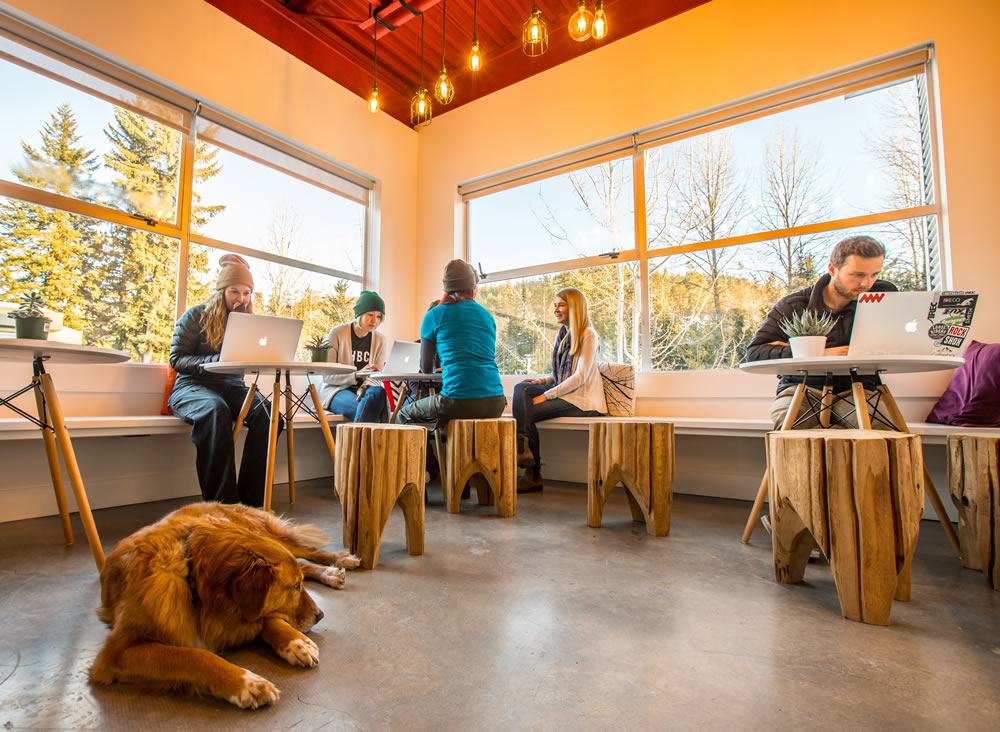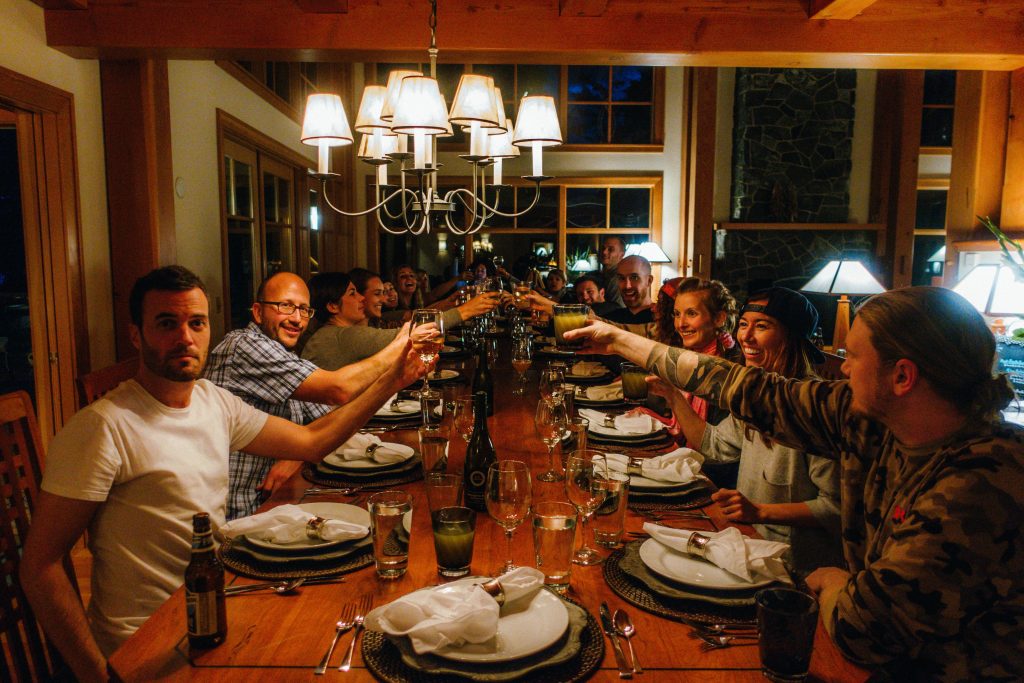
DANIELLE KRISTMANSON & MJ LEGAULT
The origins of Origin.
If a “resort marketing hall of fame” were such thing, there would likely be a wing dedicated to the efforts of Whistler- and Montreal-based Origin Design + Communications. Whether it’s full-length videos or resort magazines or branding campaigns, their strategy and creative is consistently among the best in skiing. It so happens that this agency’s story is just as good as their work.


BLANCHARD
Gregg: MJ, Danielle, let’s start at the beginning before Origin was a thing. Where were each of you and what were you doing?
Danielle: I came to Whistler in 1991, shortly after graduating from university to “ski for a season” and take a job in the marketing department of Tourism Whistler. I was a designer, writer, marketing coordinator…I did a bit of everything…just like most marketing people in DMOs do. The contacts that I met working for a large member-based organization like that made it easy for me when I decided to go out on my own three years later. I started Origin in my spare bedroom doing pretty much what I’d been doing at TW.
MJ: I did my degree in marketing at Concordia University in Montreal and was lucky enough to get picked by my marketing professor to do an internship in his agency when I was just 18 years old. That lead to a full time job working in that agency and going to school at night to finish my degree. It was an amazing experience to be working and studying for those 4 years and having that experience upon graduation.
Gregg: So when did MJ and Danielle become MJ and Danielle?
Danielle: Within a couple years I had four or five staff, but we were still very much a Whistler-based business, then a feisty Quebecer rolled into town in a beater car with her snowboarder boyfriend, weaseled her way into an interview through a friend, lied to me about her age because she thought I’d take her more seriously if I didn’t know she was only like 16…or something like that. ;)
Anyway, I hired her. After she’d worked at Origin for about 20 minutes I knew she’d likely own my business some day.
MJ: When that ski bum boyfriend of mine convinced me to move to Vancouver, I found Danielle fairly quickly upon arriving. It was exactly my dream – to live and work in Whistler and apply my marketing background to an agency that was focused on the outdoors. I did lie about my age, and I kinda still do.
Gregg: Love it. What year are we talkin’ here?
MJ: I started working with Danielle in 1998 or 1999.
Gregg: Who is Origin working with at this point and what kind of work were you doing for them?
Danielle: We were working for several local activity operators, real estate developers, etc (it was the 90’s in Whistler after all), and we were working for Whistler and Blackcomb Mountains. The eventual merger of those two companies under Intrawest, and their flurry of resort acquisitions and other businesses like real estate development, golf course management, retail and rental operations in resorts around North America opened some incredible doors for us.
Gregg: MJ, what was your role back then?
MJ: My first official role I think was “production manager”, coordinating, negotiating printing and helping Danielle to run the studio as she was still doing art direction and design back then. We realized very quickly that there were opportunities beyond the graphic design and studio demands for more marketing planning, brand creative and helping clients with various marketing problems.
Gregg: How did Origin and those skills and Whistler fit into all that was happening?
Danielle: Whistler was seen as a destination that had a magic formula, and we were seen as the agency that understood that, so our credibility was really high. Artificially high probably. But we’re smart, ;) and we learned fast and took a fake-it-til-you-make it approach. It was a few years before I realized that we actually did have real experience and expertise to offer.
MJ: We also realized within a year or two that there was some wow factor with a Whistler-based firm. That, by virtue of Origin’s location and our connection to the mountains, other resorts and other non-Whistler clients were interested in us. One of our first bigger contracts came with the (then) Intrawest Retail Group based in Golden Colorado. That lead to work with Colorado Ski Country which lead to work with other non-Whistler based resort and mountain-sport accounts.
Gregg: You’re making this sound entirely too easy.
MJ: Well, we had a lot of hurdles. But, I think they’re the same hurdles any young business would have. We needed to understand not just how to manage a business and try to be profitable, but how to build a culture that would attract and retain the best creative and strategic talent in difficult locations, how to manage budgets and cash flow, how to stay on top of marketing trends and innovation.
One hurdle for us was technology. We have an office in Whistler and one in Montreal, our team is separated by 5,000km’s (that’s a lot of miles) and our clients are all over the map, so in the early days, that sucked. We weren’t exactly faxing briefs across the country but almost. We’ve come a long way. We invested a lot, and I think today we probably have one of the most sophisticated dispersed team technology systems out there. It works for our staff, but also for our clients.
Danielle: We also have children. Are there any bigger hurdles. ;-) Mine came first, and MJ’s later, but it occurs to me that we don’t often talk about being mothers of babies and young children in the early days of our business. That, frankly, might have been some of our biggest struggles—trying to be good moms and good business owners AND good outdoor adventurers. The mountain version of supermom syndrome means you also have to keep up your skiing/snowboarding/mountain biking/travelling quota. As if just getting dinner on the table isn’t enough.
Gregg: Did the fact you were women ever play a role in other ways?
MJ: One thing we didn’t face was discrimination. I never felt at a disadvantage as a women in a (then) male-dominated industry. We felt at times a bit lonely, looking around the room at NSAA or SIA back then cause we didn’t see a ton of women around us in leadership positions. And, at times, I felt I had to speak louder and take a stand but that was fairly easy. It wasn’t a “if only I was a man, this would be so much easier” kind of thing.
Danielle: I guess this question is apropos for the day, and all of the attention on the #metoo campaign. Interestingly, I don’t ever recall feeling discriminated against. With that said it hasn’t been easy. I think we’d be naive to think that our gender never came into play in this industry. I’m grateful, however, that if it did we were green enough or ambitious enough or optimistic enough to not have been impacted by it.
Gregg: You’ve mentioned Whistler a few times. You were based in Whistler, but that’s a big name. How did you end up working with them?
Danielle: Oh this is our “Rocky” story! The one where the struggling small town agency takes it to the heavyweight champion and makes it to the big time.
OK, that’s maybe a bit dramatic, but I will always remember the celebration in the office the day we secured the Whistler Blackcomb and Tourism Whistler accounts.
In the nineties and early 2000s, pre-WB merger, we had been working for both mountains in support of the big-city agencies they used. We were doing production and smaller design jobs here and there, but both resorts were in the big agency stranglehold. We were, at the same time, working in a similar capacity for Tourism Whistler and their agency. In 2004, post WB merger, Tourism Whistler opened up a review for their agency account, and we were invited to pitch.
Gregg: Let me guess…you crushed it?
Danielle: In prepping for our pitch, we began thinking about all of the marketing inefficiencies associated with Tourism Whistler, Whistler Mountain and Blackcomb Mountain all marketing the destination individually. We developed a creative and strategy pitch that would unite the resort under one brand campaign. Tourism Whistler loved it. They fired their big-city agency, and took our pitch over to Whistler Blackcomb. The heads of both marketing departments agreed it was great work, and WB left their big-city agency for Origin soon after.
While the “one Whistler” campaign only endured for a year, the notion of creative continuity and collaboration between Whistler’s DMO and the resort has really endured since. The benefit to us working for both parties has really served us all well.
Gregg: That’s awesome. Whistler has been through a lot of changes over the years, how has Origin ebbed and flowed along the way?
Danielle: The great thing about having a client like Whistler Blackcomb, with a marketing focus like they have, is that it really pushes us to be on the leading edge of marketing trends in the industry. They’ve always been really receptive of the ideas and strategies we’ve brought to them over the years, and many times they were pushing us as well. This culture of theirs has been consistent with them, regardless of their ownership. I think Whistler Blackcomb is a really desirable place for marketers to make a career, so they have consistently had savvy people in those roles which have made the ownership irrelevant to us.
It’s early days with the Vail ownership, so it’s hard to tell how that will impact the work we do with Whistler Blackcomb, but certainly, the marketing and branding leadership at that resort continues to be extremely strong and progressive. I’m confident they’ll continue to be leaders in the industry as they have to date.
Gregg: Has Origin’s model or business or culture changed as well?
MJ: We’ve had moments when our team looked quite different from what it does today. That had to do with client shifts and economic realities, but mostly with the marketing landscape shifting and our desire to be at the forefront of content from the early stage. We went from having no video capabilities in house to having a full team of 4 to 5 full-time experts. We went from having many traditional graphic designers to a smaller team of digital-first designers. From having one strategist to having a team of account strategists as we realized that’s what our clients needed and craved.
We didn’t have a perfect number for our size (and we still don’t) but we do have the desire to make sure we can be nimble and react yet still have the team in-house to do great work and have impact in our clients’ businesses.
Gregg: Speaking of size, why is Origin the size it is? Why is it still focused on outdoors/ski when your talents clearly could fit elsewhere?
MJ: It’s because we take it seriously. It’s not just the idea that we want to merge our passions with our profession, but the idea that our business is about “inspiring people to play outside”. As business owners, we take that seriously, we’ve committed to our staff, we’ve committed to ourselves that this is what Origin is going to be really good at. We’re spending all day everyday understanding what makes outdoor enthusiasts click, what they care about, what they respond to. The size of the clients is less relevant than the ability to answer “does working with this client allow us to fulfil our vision?” If the answer is yes, we’re going to consider it. If the answer is “not really”, we’re going to pass.
One of my biggest learnings in my career (and it happened early on) was the power of saying no. Saying no to clients that did not fit with our vision, saying no to working with assholes, saying no to work that we couldn’t be proud of. It sounds counter-intuitive when you’re starting a new business but I credit those “no’s” as how we’ve been able to stay in this niche and continue to love it.
Gregg: When you started to land big clients like Whistler, were you ever tempted to go even bigger? Did you ever try?
MJ: It really depends on how you see it. For me, when I started the Montreal office, I had a list of my dream clients on the wall and worked my ass off to try to get anywhere near those. We got super lucky in getting to work with Jay Peak early on (who was on the top of that list). Then we started working with The North Face, Salomon and more recently, Lululemon and Mountain Equipment Co-op (The Canadian REI). For us, those are “big” wins.
But, outside the niche, we never pitched Audi or tried to work with Pepsi, no.
Gregg: So when you look at all the areas you work in, what’s next? For example, what do you see as the future of the outdoor experience?
MJ: There are a few key things that most of your readers are already likely aware very of. This includes the notion that story and cause are as important in a customer’s choice of a vacation destination or a new jacket. The fact that our biggest opportunities are with urban-dwelling outdoor consumers who weren’t raised on traditional outdoor activities and don’t consider themselves “outdoorsy” yet they enjoy activities that take them outside. And these new motivators (Socialization, competition, fitness) drive these consumers more than a connection with nature or a passion for the outdoors.
And, finally, let’s face it; the outdoor industry has historically been about white guys, and a lot of outdoor marketing doesn’t reflect the make-up of modern society. This has resulted in an industry that can feel elitist and un-inclusive to those that don’t look like the “typical” outdoor athlete. Traditional ethnic, gender and body-image norms in the outdoor industry alienate a massive number of potential customers, and wise brands are working to make the outdoors more inviting and inclusive to all.
Gregg: What does that mean for marketing?
Danielle: We’ve also spent quite a bit of time thinking about what’s next for marketing, and last spring we did presentations on the topic at MTS and NSAA. From very early on, we positioned ourselves at the intersection of strategy and storytelling, and that is squarely about brand building. For us, that means helping our clients tell their best stories in ways that create measurable impact.
Over the years we’ve told those stories through a lot of different channels. It started out being about advertising, then it became about our clients’ websites, then it became about social, and then it became about content. Our presentation last spring was called “What Happens After the Content Bubble Bursts”. We’re keeping a really careful eye on that, and we pride ourselves in being nimble enough over the years to always be one step ahead of a trend so we’re giving our clients the best opportunity to not be behind a wave when it crests.
With that said, content has a stronghold in the marketing landscape. How content is being used, is what’s changing. We’re seeing content marketing coming back to some of its earliest applications—pre-native advertising. Creating stories for our clients with partners who can amplify reach and build on brand relevance is a place where we see lots of interesting opportunities emerging.
Gregg: And, finally, what’s does the future hold for Origin?
Danielle: We’ve built Origin to be uniquely well-suited for this newest trend. The difference between us and a video production house, or between us and content developers, or us and web agencies is the strategy we apply. Our marketing and distribution strategists make sure that the stories we’re telling are making it to the consumer in the most rewarding and innovative way possible. For us, it’s the perfect application for our longtime strategy and storytelling position to come to life.
About Gregg & SlopeFillers
I've had more first-time visitors lately, so adding a quick "about" section. I started SlopeFillers in 2010
with the simple goal of sharing great resort marketing strategies. Today I run marketing for resort ecommerce and CRM provider
Inntopia,
my home mountain is the lovely Nordic Valley,
and my favorite marketing campaign remains the Ski Utah TV show that sold me on skiing as a kid in the 90s.
Get the weekly digest.
New stories, ideas, and jobs delivered to your inbox every Friday morning.


